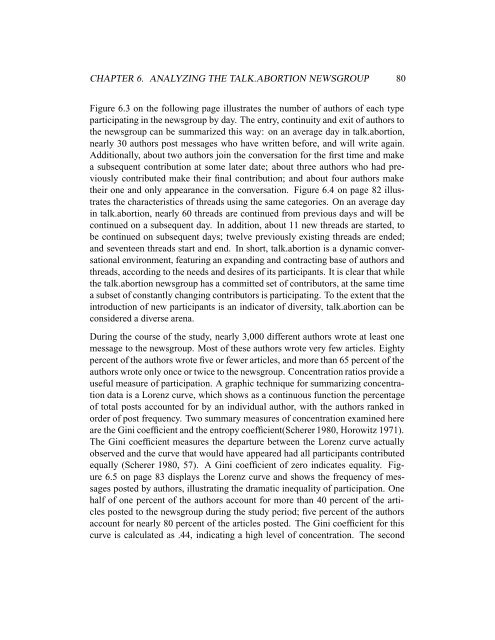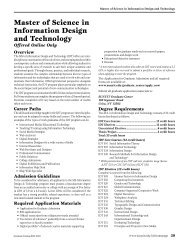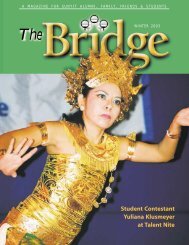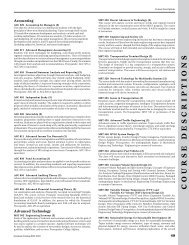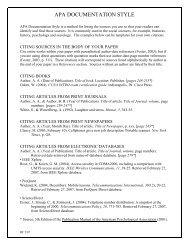Expanding the Public Sphere through Computer ... - ResearchGate
Expanding the Public Sphere through Computer ... - ResearchGate
Expanding the Public Sphere through Computer ... - ResearchGate
You also want an ePaper? Increase the reach of your titles
YUMPU automatically turns print PDFs into web optimized ePapers that Google loves.
CHAPTER 6. ANALYZING THE TALK.ABORTION NEWSGROUP 80<br />
Figure 6.3 on <strong>the</strong> following page illustrates <strong>the</strong> number of authors of each type<br />
participating in <strong>the</strong> newsgroup by day. The entry, continuity and exit of authors to<br />
<strong>the</strong> newsgroup can be summarized this way: on an average day in talk.abortion,<br />
nearly 30 authors post messages who have written before, and will write again.<br />
Additionally, about two authors join <strong>the</strong> conversation for <strong>the</strong> first time and make<br />
a subsequent contribution at some later date; about three authors who had previously<br />
contributed make <strong>the</strong>ir final contribution; and about four authors make<br />
<strong>the</strong>ir one and only appearance in <strong>the</strong> conversation. Figure 6.4 on page 82 illustrates<br />
<strong>the</strong> characteristics of threads using <strong>the</strong> same categories. On an average day<br />
in talk.abortion, nearly 60 threads are continued from previous days and will be<br />
continued on a subsequent day. In addition, about 11 new threads are started, to<br />
be continued on subsequent days; twelve previously existing threads are ended;<br />
and seventeen threads start and end. In short, talk.abortion is a dynamic conversational<br />
environment, featuring an expanding and contracting base of authors and<br />
threads, according to <strong>the</strong> needs and desires of its participants. It is clear that while<br />
<strong>the</strong> talk.abortion newsgroup has a committed set of contributors, at <strong>the</strong> same time<br />
a subset of constantly changing contributors is participating. To <strong>the</strong> extent that <strong>the</strong><br />
introduction of new participants is an indicator of diversity, talk.abortion can be<br />
considered a diverse arena.<br />
During <strong>the</strong> course of <strong>the</strong> study, nearly 3,000 different authors wrote at least one<br />
message to <strong>the</strong> newsgroup. Most of <strong>the</strong>se authors wrote very few articles. Eighty<br />
percent of <strong>the</strong> authors wrote five or fewer articles, and more than 65 percent of <strong>the</strong><br />
authors wrote only once or twice to <strong>the</strong> newsgroup. Concentration ratios provide a<br />
useful measure of participation. A graphic technique for summarizing concentration<br />
data is a Lorenz curve, which shows as a continuous function <strong>the</strong> percentage<br />
of total posts accounted for by an individual author, with <strong>the</strong> authors ranked in<br />
order of post frequency. Two summary measures of concentration examined here<br />
are <strong>the</strong> Gini coefficient and <strong>the</strong> entropy coefficient(Scherer 1980, Horowitz 1971).<br />
The Gini coefficient measures <strong>the</strong> departure between <strong>the</strong> Lorenz curve actually<br />
observed and <strong>the</strong> curve that would have appeared had all participants contributed<br />
equally (Scherer 1980, 57). A Gini coefficient of zero indicates equality. Figure<br />
6.5 on page 83 displays <strong>the</strong> Lorenz curve and shows <strong>the</strong> frequency of messages<br />
posted by authors, illustrating <strong>the</strong> dramatic inequality of participation. One<br />
half of one percent of <strong>the</strong> authors account for more than 40 percent of <strong>the</strong> articles<br />
posted to <strong>the</strong> newsgroup during <strong>the</strong> study period; five percent of <strong>the</strong> authors<br />
account for nearly 80 percent of <strong>the</strong> articles posted. The Gini coefficient for this<br />
curve is calculated as .44, indicating a high level of concentration. The second


